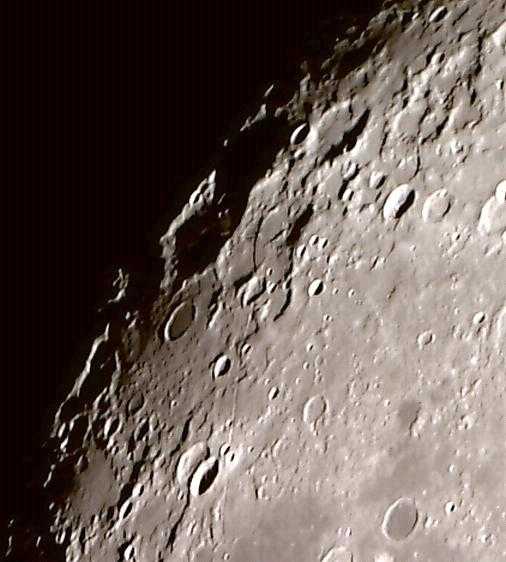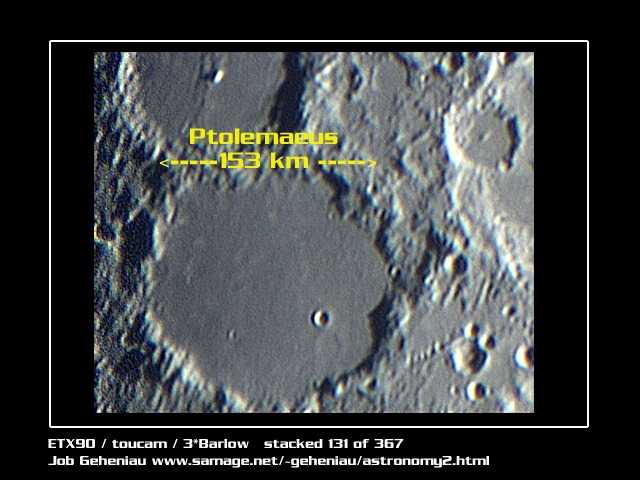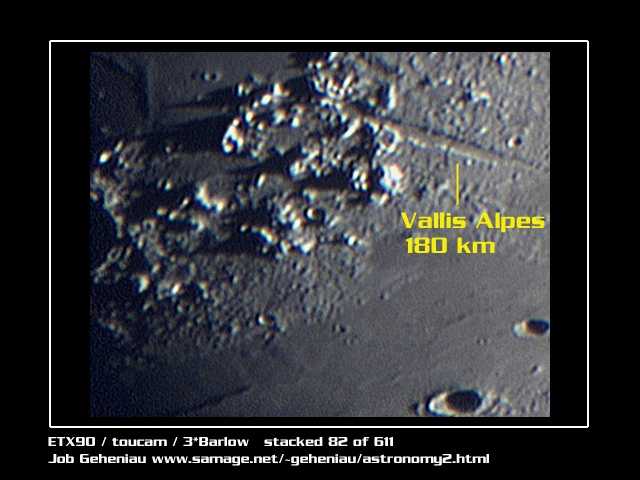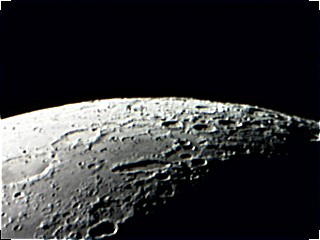| Michael Paul DiOrio (mpdiorio@mac.com) [31 Mar 04] |
 |
a new moon pic with:
ETX 125 Meade 40mm plossl. Scopetronix digi T with Nikon Coolpix 4300
on auto.
Photoshop Elements unsharp mask and color removal.
|
| leutloffa@juno.com [31 Mar 04] |
 |
lots of chatter about the triple shadow's on Jupiter...Here is a shot taken with my ETX 125 and Toucam Pro taken of the craters Ptolemaeus, Alphonsus, and Arzachel on 3-28-04. 300 frames stacked wih registax. Seeing conditions were a 8 out of 10...and the moon at zenith. Alan
|
| Dieter.Wolf@DNSint.com [8 Mar 04] |
 |
Dieter Wolf (Munich, Germany); 2004-03-04 22:35 CET (21:45 UTC); MEADE
ETX-125EC with PHILIPS ToUCam pro (300 frames); south up, east left
(please don't flip Mike)
This is a much better shot (than the one I sent you a few weeks ago) of
Rimae Sirsalis, the longest rille system on the moon. Starting at the small
crater on the bottom of the picture, running up over more than 300km and
going through highlands and some craters. Part of it is sunlit-bright,
others are dark. In some parts this 'Rima' is less than 3km broad. Have a
look at the sunlit mountain tops, the dark shadows of mountains and crater
walls and the lava-filled crater right-down on the photo.
|
| James Jefferson-Wilson James (james.jefferson@bbc.co.uk) [4 Mar 04] |
 |
Details: Moon Shot with 32mm Eyepiece.
Copernicus Shot with 2 X Barlow / 12.4mm Meade Eyepiece.
|
| geheniau@xs4all.nl [4 Mar 04] |
   |
Good seeing so 3 times the moon with some 'scientific' explanation. Made with the Mighty ETX90.
|
| mark mathosian (mmathosian@comcast.net) [8 Feb 04] |

Click for full-size image |
|
Here's a nice shot from about 6:30 am this morning.
Mike here: Cropped from the original image.
|
| Dieter.Wolf@DNSint.com [8 Feb 04] |

 |
I pass you along a cropped animated GIF-file of Rima Sirsalis where I
marked the Rima. I think it was hard to find on the last posting which you
flipped by 90 degrees so that the picture and description didn't match.
Don't tell me no one recognized at all.....
Please find attached too a new one of 'Vallis Schroter' -'Schroeter Tal' in
German (a 'valley' winding over 165km, 6-10km broad and up to 1000m deep)
starting at crater Herodotus (36km in diameter) Astonishing in this
region is one of the brightest spots on the moon's surface: crater
Aristarchus. Sometimes you can even see him if not sunlit!
Dieter Wolf (Munich, Germany); 2004-02-03 22:00 CET (21:00 UTC); MEADE
ETX-125EC (5", 1900mm) with Philips ToUCam pro at prime focus; 85 out of
860 frames (not a really good picture); south up, east left
|
| Dieter.Wolf@DNSint.com [4 Feb 04] |
 |
still watching the moon - thanks for posting.
This is a not so popular formation on the moon: Rima Sirsalis It is a
400km long, small 'Rima' outside of Oceanus Procellarum near by the double
crater Sirsalis (43km diameter) going straight through the bright, small
crater Sirsalis J (12km) up to the top end of the photograph. It is an
interesting formation especially because of its LOCATION. One would expect
'Rimae' in lava filled areas like 'Maria' or large craters because they ARE
lava canals. This one runs through hills and highlands and its origin is
still under discussion.
(See attached file: RimaSirsalis.jpg)
Dieter Wolf (Munich, Germany); 2004-02-03 22:00 CET (21:00 UTC); MEADE
ETX-125EC (5", 1900mm) with Philips ToUCam pro at prime focus; 350 out of
650 frames; south up, east left
Bye the way: What does 'south up, east left' mean on the moon's surface?
Well, it depends upon if you're looking at it as an ASTRONOMER or an
ASTRONAUT. As an ASTRONOMER we have east to our left hand and west to our
right if we're looking towards the moon. Now turn around 180 degrees and
imagine you were an ASTRONAUT on the moon, looking towards earth. You would
be absolutely right to say: to my left hand the sun is rising so I call it
east. But that's what we - on earth - see on the right side of the moon -
thus calling it west! Take care with cards of the moon too; both east-west
systems exist.
|
| James Jefferson-Wilson James (james.jefferson@bbc.co.uk) [4 Feb 04] |
 |
Had terrible weather in the UK, but managed good viewing on the 27th.
Used 26mm on the main pic and 18mm on the others.
Please consider for your Lunar Gallery, Thank you.
|
| sallet (franck.sallet@tiscali.fr) [4 Feb 04] |
 

|
Thank you for your site, very very cooool !
I'm in love for my etx as the first time since I discovered your site :-)
This is a photo of moon, taken at 20h30 this day, with etx 90 and autostar suite and no barlow.
I have forgotten to give you my observation's site.
I live in paris, I have an etx 90 and an autostar suite.
I'm decided to make a lot of photos these next months of moon, jupiter and saturn.
PS : no barlow used for these photos.
|
| Dieter Wolf (WolfDieter@t-online.de) [31 Jan 04] |


 |
the THIRD clear night yesterday, we're starting to get blessed...
I tried to catch comet 'Linear'. Unspectacular; I'm still not quite sure if I have seen him in my 20x80 binocular in that moonlit night. So, if moonlit, why not look at the moon?
Dieter Wolf (Munich, Germany); 2004-01-30 20:30 CET (19:30 UTC);
MEADE ETX-125EC (5 inch, 1900mm) with Philips ToUCam pro at prime focus; 1/100s; south up, east left;
[Top] Montes Apennines; 1000km long and up to 5500m high mountains at the southern end of Mare Imbrium; look at the shadows of the mountains and the white mountain tops; 30 out of 300 frames
[Middle] Plato with Montes Alpes (260km long and up to 2400m high), Vallis Alpes (135 km long) and some isolated hills like Mount Piton (35km in diameter) on top of the photograph; look at the totally lava flooded crater south (up) of Plato; 20 out of 250 frames
[Bottom] Rupes Recta a 115km long and 300m deep dislocation, ending up in the north (down) in a small crater with 5km diameter; the smallest craters you can resolve in this photograph are below 4 km in diameter, thus pretty close to what's possible; 25 out of 400 frames
I know our 'deep sky colleagues' dislike him, others simply ignore him, but it's always worth to do an 'eye-walk' on our moon's surface...
Thanks Mike for posting on your beautiful site...Dieter
|
| GONZALO GRANER (g_graner@hotmail.com) [31 Jan 04] |
 |
Here's a nice moon shot from Caracas (Venezuela 27/01/04 07:34 p.m.)
shot through ETX70, 25mm lens, Nikon Coolpix 2.100, moon filter, 3X Barlow
lens and I also used the NikonView software.
|
| James Jefferson-Wilson James (james.jefferson@bbc.co.uk) [28 Jan 04] |
 |
Could you please consider this for the your Lunar Gallery. This is a raw image and one of the best I have taken. Unfortuately the skies clouded over not long after.
|
| mark mathosian (mmathosian@comcast.net) [19 Jan 04] |
 
|
[Top] Here is a moon shot from Naples from 1/17/04 at about 4:45 am. Photo shot through an ETX90 with a Philips ToUcam camera. Stacked about 45 images in Registax.
[Bottom] Moon shot from 1/17/04. shot through ETX90 with Nikon Coolpix 995 and 18 mm wide angle lens.
|
| James Jefferson-Wilson James (james.jefferson@bbc.co.uk) [19 Jan 04] |
 |
This is the one of my best astrophotographs, taken 1 day after full moon (full moon day was cloudy). Very pleased
With this. Could you please consider for your gallery. Thank you very much.
Also a quick question: Im looking to upgrade my ETX90 for a ETX125, would you recommend this ? Is there "that"
Much of a difference ?
Mike here: Yes, there is a difference. But whether it will be enough of a difference for you depends upon what you expect and plan to do with the larger telescope.
|
| mark mathosian (mmathosian@comcast.net) [15 Jan 04] |
 |
|
here's a nice moon shot from this morning. ETX90, 32mm lens, Nikon Coolpix 995.
Mike here: Cropped from the original full-frame version.
|
| mark mathosian (mmathosian@comcast.net) [8 Jan 04] |

Click image for full size view (284k)
Click image for full size view (364k)
|
Here is the first full moon for 2004. Photographed with an ETX90, 32mm lens, Nikon Coolpix 995, moon filter.
|
| Greg Fraker (gregfraker@hotmail.com) [4 Jan 04] |
 |
I'm new to astronomy and received an ETX-70AT for Christmas. I took this
photo on 1/3/04 using my Pentax Optimo 230 (digital camera - 2.0
megapixel) afocally. I sharpened the photo using ACDSee software. As far as
eyepieces, I can't remember what I used for this specific photo. (I took
about 30 photos of the moon; I used the 9mm and the 25mm eyepieces that come
with the ETX-70AT; I also used the 2X Barlow lens on several photos.) Does
anybody have an idea on how I can eliminate the green line around the moon?
Also, I think I need to work on the focus (either the telescope and the
camera, or both). Other than that, I'm pretty pleased with my first attempt
at astrophotography.
|
| geheniau@xs4all.nl [4 Jan 04] |
 |
Crater Copernicus on Moon
Job Geheniau
The Netherlands
By The Way: Bad Seeing and bad transparancy this night.
|